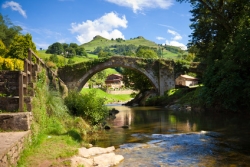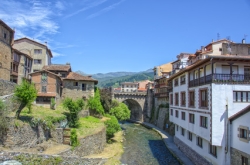Cantabria
Cool Cantabria, Spain's Green Playground

Old bridge over Miera river in Liérganes
It's not unreasonable to suggest that Cantabria is where Spain
is at its most contented. The northern region nestles between the
Basque Country and Asturias, both hotbeds of fierce, and
occasionally violent, separatist sentiments. Cantabria's rugged
mountains and enticing beaches harbour less anger, more a sense of
serenity, characterised by the rolling pastures and blithe villages
of this picturesque realm.
It's a land of milk and honey, literally so as the producer of a
large percentage of Spain's dairy produce, and the delicious
organic miel produced by the hives in the Cantabrian
countryside. If the local economy relies on the herds lowing
happily in the lush green valleys, the tourist influx is mostly
drawn by the montes y mar: mountains and sea.
Start at the sea, and the string of secluded Biscay beaches that
nestle at the foot of imposing cliffs. Wealthy Madrid families head
here for their summer break from the capital. The Cantabrian coast
is the antithesis of the brash and crowded resorts of the costas,
an idyllic escape where temperatures rarely get oppressive.
It would be difficult to find a better base than the beautiful
medieval market town of Comillas. It's an unpretentious,
well-preserved little place, with its own superb beaches. It also
boasts El Capricho, a green and gold ceramic tiled house with an
ornate tower, reflecting the playful exuberance of its creator, the
Catalan architect Antoni Gaudi.

The trailhead town of Potes
The mountains are always looming in Cantabria, just a short
drive from the sea. The Picos De Europa, part of the Cordillera
Cantabrica, are perfect for hiking, climbing and mountain-biking
breaks. Pitch up in the trailhead town of Potes, and you'll find
like-minded outdoor types from all over the world. This is the
place to stock up on mountain equipment, fill your water-bottles
and invest in some excellent ham and Cabrales cheese for the long
hikes through some of Spain's most spectacular scenery.
Before you hit the high trails, and enjoy the amazing cable car
ride up the mountain side at Fuente Dé, take a detour down the
valley from Potes to the atmospheric church of Santa Maria De
Lebeña. It was built in 925, but its main attraction is the
relatively new (14th century) sculpture of the breastfeeding
Madonna. She was stolen in 1993, and recovered, eight years
later, in an apartment in Alicante. Locals swear that the sculpture
came back with a slight suntan from her sojourn down south.
The entry point to the region for many visitors is by sea, at
the impressive port of Santander, served by direct ferries across
the Bay of Biscay from southern England (Plymouth or
Portsmouth to Santander with Brittany Ferries) and Brittany.
Santander is as urban as Cantabria gets, but even here the
atmosphere is mostly pleasantly provincial.
Visitors, tipped off by their hoteliers, gravitate towards the
Barrio Pesquero, where simple fish restaurants serve up the fresh
catch, beautifully prepared. Golfers are obliged to make a
pilgrimage over the bay to Pedreña, where the late, great Severiano
Ballesteros learned his lucrative trade, chipping golf balls
through the dunes. A leisurely afternoon by the sea in
Santander will persuade you that Cantabria has every reason to be
pleased with itself.